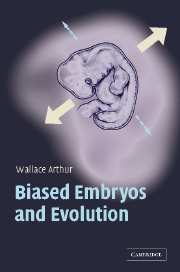Book contents
- Frontmatter
- Contents
- Preface
- Acknowledgements
- 1 The microscopic horse
- 2 What steers evolution?
- 3 Darwin: pluralism with a single core
- 4 How to build a body
- 5 A brief history of the last billion years
- 6 Preamble to the quiet revolution
- 7 The return of the organism
- 8 Possible creatures
- 9 The beginnings of bias
- 10 A deceptively simple question
- 11 Development's twin arrows
- 12 Action and reaction
- 13 Evolvability: organisms in bits
- 14 Back to the trees
- 15 Stripes and spots
- 16 Towards ‘the inclusive synthesis’
- 17 Social creatures
- Glossary
- References
- Index
15 - Stripes and spots
Published online by Cambridge University Press: 02 December 2009
- Frontmatter
- Contents
- Preface
- Acknowledgements
- 1 The microscopic horse
- 2 What steers evolution?
- 3 Darwin: pluralism with a single core
- 4 How to build a body
- 5 A brief history of the last billion years
- 6 Preamble to the quiet revolution
- 7 The return of the organism
- 8 Possible creatures
- 9 The beginnings of bias
- 10 A deceptively simple question
- 11 Development's twin arrows
- 12 Action and reaction
- 13 Evolvability: organisms in bits
- 14 Back to the trees
- 15 Stripes and spots
- 16 Towards ‘the inclusive synthesis’
- 17 Social creatures
- Glossary
- References
- Index
Summary
If we judge the advent of evo-devo in the 1980s from the standpoint of evolutionary modes, it conforms better to the ‘explosion’ mode than to the ‘plodding’ one. The spark that lit the fuse was the discovery of this thing called the homeobox. So I had better explain that first. It emerged, as many scientific discoveries do, in two separate places at about the same time – a bit like Darwin and Wallace coming up, independently, with the idea of natural selection. In the case of the homeobox, the two groups that made the discovery were in Indiana and Switzerland.
The homeobox is a stretch of DNA that has a particular sequence of building blocks (nitrogenous bases). In total it has about 180 of them. This is a short stretch of DNA when compared with the total length of a typical gene, which has thousands of bases. So when biologists use the phrase ‘homeobox gene’, they do not mean that some genes are homeoboxes – rather that they have homeoboxes. That is, somewhere along the length of the whole gene there is a homeobox; and exactly where this ‘box’ appears varies from gene to gene.
As you may already know, geneticists have a habit of calling various recurring sequences of DNA ‘boxes’. This particular box gets its ‘homeo’ prefix from the fact that it was initially discovered in genes that caused particular kinds of mutant phenotype, where the right thing appears in the wrong place – like the ‘antennapedia’ fly that I mentioned earlier with legs growing out of its head.
- Type
- Chapter
- Information
- Biased Embryos and Evolution , pp. 174 - 189Publisher: Cambridge University PressPrint publication year: 2004



